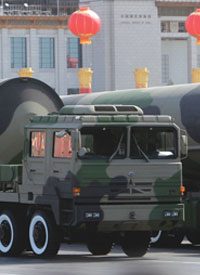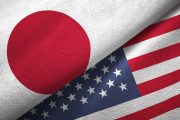
Item: A senior Chinese general, reported Xinhua, China’s state news agency, on September 1, just met in Beijing “with the head of a leading U.S. think tank and discussed the building of strong military ties between the two countries, despite military exchanges between the two nations having been frozen since January. ‘A sound and stable China-U.S. military relationship is good for bilateral strategic trust and regional peace and stability,’ Deputy Chief of the General Staff of the Chinese People’s Liberation Army (PLA) Ma Xiaotian told John Hamre, president of the Washington-based Center for Strategic and International Studies (CSIS)…. ‘China has always attached great importance to developing military ties with the United States and has made efforts in this regard,’” said Ma.
Item: In late August, wrote Douglas H. Paal, a vice president at the Carnegie Endowment for International Peace and a former official with JPMorgan Chase International and the National Security Council, “the Obama administration seized the opportunity of a visit by the Chinese official most directly responsible for daily dealings with the United States to try to redirect relations with China in a more positive direction from the bumpy course of the past few months.”
In a “Carnegie Commentary” dated September 1, Paal anticipated that the next several months “will produce a sequence of opportunities to reset the relationship. Premier Wen Jiabao will attend the U.N. General Assembly in New York in late September and President Obama is expected to meet with him bilaterally to press the U.S. agenda — from international finance, to bilateral trade issues, to sanctions on Iran. Senior officials from Commerce will travel to Beijing in October to participate in the Joint Committee on Commerce and Trade.”
Correction: China does not want to develop “military ties” with Washington and “reset a positive course” because Beijing loves “peace” and has warm fuzzy feelings for Americans and hopes to enhance the influence of the United States. Anyone who really thinks that is naïve beyond help; many of the policymakers who pretend this to be the case are dangerously duplicitous. Communist China is on a long march for more power.
For decades, as a few stalwarts in the U.S. Congress used to point out, the Communist Chinese have been increasingly focused on acquiring U.S. and foreign technology and equipment — in particular dual-use technologies that can be integrated into the People’s Republic of China’s military and industrial bases. What isn’t bought or otherwise transferred is often stolen.
Moreover, as the Cox Committee in the U.S. House noted as long ago as 1999, “The PRC has also purchased weapons systems or their components from Israel, France, Britain, and the United States, including air-to-air missiles, air-refueling technology, Global Positioning System (GPS) technology, helicopter parts, and assorted avionics.”
Yet, there are those who still feel reassured that the Chinese — the largest foreign holders of U.S. debt in the world — would not cut off their nose to spite their face and risk their investments in U.S. holdings.
That argument hasn’t convinced the Chinese military. “China’s military stepped up pressure on the United States on Monday,” reported the Washington Times earlier in the year, “by calling for a government sell-off of U.S. debt securities in retaliation for recent arms sales to Taiwan. A group of senior Chinese military officers also said in state-controlled media interviews that Beijing’s leaders should boost defense spending and expand force deployments in the wake of the Pentagon’s announcement last month [January] of a new $6.4 million arms package for the island state claimed by Beijing.” A number of senior military officers “from the Chinese National Defense University and Academy of Military Sciences made what some view as an economic warfare threat, something outlined in past military writings.”
Perhaps it wouldn’t be economically “rational” for Beijing to turn on its suppliers of technology, but world powers don’t always play by the rules that are followed by the advisors to the State Department. The military and the Communist Party are ultimately calling the shots in China, not market-driven economists.
While the relationship between China and the United States does shift and sometimes seems hotter or cooler on the surface, it generally reverts to the advantage of Beijing. This happened, for just one example, when the memory of the Tiananmen Square massacre faded. This can be largely attributed to the fact that China is our largest debt holder and is willing to use the debt for leverage. Even the Chinese theft of U.S. military secrets goes by with relatively little fuss by our government.
The latest report on Chinese military power by the U.S. government, which by law is supposed to be released annually, was delayed for more than five months this year — a move that most analysts see as a political appeasement by the Obama administration to avoid offending Beijing. However, the Chinese, as they always do, denied all accusations of ill-gotten gains and huffed and puffed angrily at the release of the Pentagon’s document.
This year’s document had its name altered a bit, reflecting the White House’s belief in “soft power,” being dubbed “Military and Security Developments Involving the People’s Republic of China,” rather than “Military Power of the People’s Republic of China.” There was a lot left unsaid in the document, and not because the Chinese are growing weaker. A better guess might be that the verbiage was toned down so not to alarm the American public. The major impact of U.S. technology on China’s defense development, for example, was glossed over or subsumed into very general terminology. Nevertheless, the latest Pentagon report does note:
China relies on foreign technology, acquisition of key dual-use components, and focused indigenous research and development to advance military modernization.
The PRC utilizes a large, well-organized network of enterprises, defense factories and affiliated research institutes and computer network operations to facilitate the collection of sensitive information and export-controlled technology….This network of commercial and government-affiliated companies and research institutes often enables the PLA to gain access to sensitive and dual-use technologies or knowledgeable experts under the guise of civilian research and development….
In the case of key national security technologies, controlled equipment, and other materials not readily obtainable through commercial means or academia, the PRC resorts to more focused efforts, including the use of its intelligence services and other-than-legal means, in violation of U.S. laws and export controls.
The Pentagon report also notes that Beijing has been modernizing its nuclear forces by adding systems that make them more survivable. For example, says the report, the road-mobile, solid-propellant “DF-31 and DF-31A intercontinental range ballistic missiles (ICBM) have entered service. The DF-31A, with a range in excess of 11,200 km, can reach most locations within the continental United States (CONUS). China may also be developing a new road-mobile ICBM, possibly capable of carrying a multiple independently targeted re-entry vehicle (MIRV).”
What the Department of Defense report most emphatically does not say is where that DF-31 technology came from, although it is hardly a secret: the U.S. of A. Even the warheads now on Chinese nuclear weapons are believed to be derived from espionage directed at this country and our systems.
Author Bill Gertz pointed out in The China Threat a full decade ago how Lockheed scientists had earlier traveled to China to help out the communists with problems they were having with rocket motor failures. As Gertz wrote:
Solid rocket technology — like other technical assistance Lockheed supplied the Chinese — is critical in helping the Chinese develop multiple independently targeted reentry vehicles, or MIRVs. The rockets can be adapted to guide clusters of nuclear warheads launched on a single missile. As the Cox Committee stated, China has threatened to “MIRV” its warheads in response to U.S. national missile defenses. So far, China has not deployed MIRVs on its current nuclear arsenal but has shown the capability of adding up to three warheads on its new DF-31 truck mobile intercontinental ballistic missile. The DF-31 was flight tested for the first time in 1999 with “penetration aids” — dummy warheads designed to fool missile defenses. These used “kick motors,” another technology on which Lockheed provided assistance.
Meanwhile, a RAND Corporation report found that U.S. air power in the Pacific would be “inadequate to stop a hypothetical Chinese attack on Taiwan in 2020, with U.S. stealth fighters being unable to evade China’s CETC Y-27 radars.
Yet, while some in the Pentagon and a few others point to the growing threat of China, the liberal establishment seems to be gearing up for another thaw with Beijing, which inevitably makes China even stronger.
During President Obama’s state visit to Beijing in November 2009, he promised comprehensive relations with China. Wouldn’t you know that the one promise the President keeps would be approved by Beijing.
— Photo: AP Images



